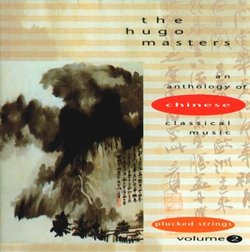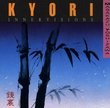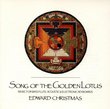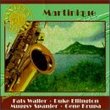Excellent Tones and Vibrant Timbre
Kean Chhay Chang | Vic, Australia | 08/26/2002
(5 out of 5 stars)
"The music is very touching and moves the soul as the listener ponders, reminisces over the compositions and their titles which some are very graphical and radical to some extent. For instants track one titled "Ambush" played by a pi-pa (Chinese pear shape lute with four strings much similar to the Japanese Biwa). The music is very descriptive in it's tones and timbres and the way that it is strummed like a guitar however with more vibrancy and their I can to some extent visual the whole scene of the ambush taking place with arrows flying and near the end I could hear what sound like the cries of horses and men as they fall or are charging at their enemies from the rapid puckling techinque which makes the pi-pa best played as a solo. I have another version of track 2 "Like Waves Against Sand". The version I have the music is played at a slower pace. Thus the musician has their own style of playing and certain areas their interpretation was very unique expressing what their thoughts and ideaology. The Sword dance played by the liu ch'in which looks like a smaller version of the pi-pa but with a higher pitch. The music seemed to have this European and Islamic sense in it. Some parts sound nothing like Chinese and I guess the music during the Tang Dynasty was often incorporated new concepts and ideas which makes it sound so unusal. Track 4 played by the zhong-ruan which looks like a guitar with a round sound box playing the "Moonlit Night Of Stone Forest" is my favourite because it starts off slow with the strumming and plucking sound which sounds like a guitar but it becomes more rapid sound more like a Spanish Flemenco guitar as well as the style used by the chapey a traditional Cambodian long neck lute. It's my favourite music because, it's very rapid and I like the strumming effect as the musician is trying to convey his/her idea. This is the first time I have head the ruan being played solo because most of the Chinese music I have contains ruan playing in an orchestra but only playing the chords or playing the bass like a bass in a guitar. Petrel for track 5 is somewhat unusual and I don't like it because it sounds too Western sounding more like a piano rather than a hammered dulcimer called yang ch'in meaning foreign lute. My other favourite track is "Beyond the Great Wall" the music is very mellow and at times has that twanging effect which sounds almost like Japanese or Vietnamese music. The sound of the flute floating over the twanging tones and timbres of the san-hisen a three stringed lute with no fret reminds me the sounds of an American banjo. The music is rapid and tended to slow down and then become rapid again. It's haunting and kind of said as the the sleeve notes suggests. To go beyong the Great Wall from my point of view it might mean to go beyond China's frontier into a foreign and unfamiliar land or it cound mean to go beyond the large palace walls? Since once people were recruited into the palace grounds they would never leave the palatial grounds since they lived and died within the palatial grounds. That's my interpretation. The mood is very sad because, it conveys to me the throughts and feelings of sadness and the pondering of what happens when she does leave what is so familiar to her. That's my interpretation.Other intruments include the zheng a 16 stringed zither much similar to the Japanese koto. The two pieces are played different the more slow and relaxing one called the "Defeating Song of the Chu" is a very mellow, bitter sweet music as the musician plucks. Zheng is a popular instrument "High Mountains and Flowing Water" such rapid but sweet tones can be make the situtations very dreamy. This is a very gu-zheng piece of music. I hear it in nearly every gu-zheng recording. I have often enjoyed the soothing tones of the zheng and the way that it's being played and pluck and the plucking style could vary as well as often as I have heard. The Southern style of music from Canton (Guandong) and also Chao Zhao AKA Teo Chew music their style is very strong to delicate plucking since there are so many schools with different playing techniques.The last two compositions performed by the ch'in a seven stringed long black zither has their unusual sound like someone strumming a guitar and plucking the wrong keys or strings. This music is always enjoyable to my ears because they are relaxing and often the music tended to have descriptive tones which seems to be very primordial. Quite relaxing and sooths the soul and was often considered one of many treasures that a scholar in China should possess. The Parting at Yangguan is another famous piece that was written for the ch'in. It was based on a Chinese poem in the Tang Dynasty and it song was called Song of Wei City which was later on adapated into this fine composition. Its sad but melodic and gives that sense of a friend leaving and its a very mournful farewell.The broken string techinque demonstrated on the zheng is very good and has an effect that a string is being broken in fact it's not.Overall the music is wonderful and recordings are great. Wonderful selections of the music and I seemed to really enjoy it. Apart from this music there are a few other cd recorded on Chinese music including bowed, wind and percussion. The liner notes are very helpful in the description but they should have pictures to show what each instrument looks like."


 Track Listings (11) - Disc #1
Track Listings (11) - Disc #1



